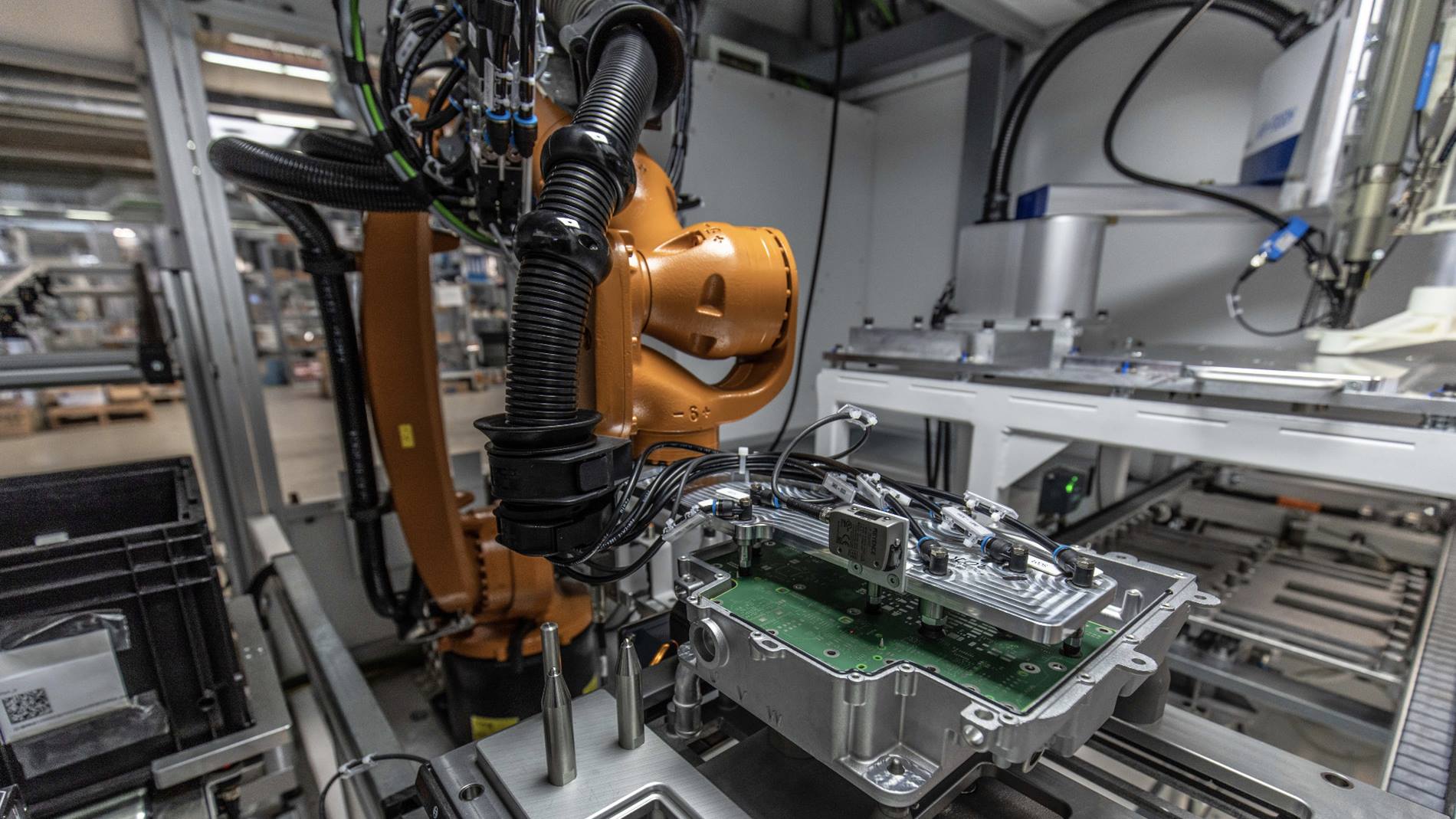 Klein, aber oho! Die Steuereinheiten eines E-Autos, gefertigt mit Hilfe von KUKA Robotern
Klein, aber oho! Die Steuereinheiten eines E-Autos, gefertigt mit Hilfe von KUKA Robotern
With the help of eleven KUKA robots and 17 HIRATA screwdriving robots, SAR developed a fully automatic, scalable production line for the heart of electric cars.
The electronics assembly is the heart of every electric car. It is only slightly larger than a shoe box, weighs around twelve kilograms and converts the direct current from the batteries into alternating current. The technology is relatively new for the automotive industry: suitable concepts for intelligent production are therefore required. SAR from Dingolfing in Bavaria has therefore developed a production line for the electronic assemblies of electric cars on behalf of a Tier 1 supplier.
“Our aim is to find intelligent solutions using the robot tool that the conventional approach cannot achieve,” explains Georg Dullinger, Sales Manager at SAR. The result is automated production that not only assembles assembly parts, but also controls and monitors all process steps, from the labeling of the individual parts, to the screwing and gluing tasks, to tests and inspections of the intermediate steps and the finished product.
Maximum flexibility
“It’s not enough to just line up robot cells,” explains Dullinger. “There is no blueprint for these processes, no best practices.” Therefore, SAR developed solutions for all individual steps of automation – and the intelligent connection to an overall concept – long before the car models were ready for series production. “The challenge is the high degree of flexibility: there were repeated changes to the final model throughout the entire development phase. Only the dimensions of the vehicles were set. But the inner workings were heavily modeled.”
In the current configuration of the production line, 28 robots are now in use, eleven of which come from Kuka. They take on all the tasks involved in screwing, gluing, testing and ultimately marrying 47 individual vehicle components with the car. The individual assembly steps initially sound unspectacular: the industrial robots insert various electronic components into the housing of the control unit for the e-cars. They clean and check, sort out or rework.
Screws in the clean room
Due to the sensitive electronics, however, assembly must be carried out carefully and precisely. This means, for example, that splices are first cleaned in the manufacturing process. To do this, a KR Agilus from Kuka traces the areas with a plasma lance and removes dirt particles and other contamination with ionized gas at a temperature of 30,000 degrees. The robot then applies sealant. A KR Cybertech inserts various components into the housing. “Even the smallest electrical currents can destroy the sensitive components,” says Franz Steinbauer, “therefore electromagnetic compatibility is particularly important here.”
A robot then screws the components together. “We use a total of 158 screws in eight different variants,” explains the project manager. “The system feeds a screw every four seconds via a hose.” What sounds trivial is in practice more complicated: Because the screws are delivered in bulk and this type of packaging automatically creates abrasion between the individual metal parts, a switch separates them with help from compressed air screws and dust. The assembly takes place practically under clean room conditions.
Complete data tree collected
“We record a so-called data tree for each component throughout the entire assembly process. That means, from the smallest screw to the housing cover of the electric vehicle, we can understand exactly how it was processed,” explains Sales Manager Dullinger.
In between, leak tests and functional tests are carried out again and again. The last step is particularly exciting: a KR Cybertech robot takes the finished control units for the e-cars off the assembly line and fills them with water. “Actually, water, electricity and data technology should never meet,” says SAR project manager Franz Steinbauer. “But in this case we bring everything together within about 100 seconds, the water is used for cooling.”
Finally, the Kuka robot places the control units in the high and low voltage insulation test. Then the electric hearts get their operating system installed. If all tests are positive and the water is drained again, the control units are ready for their life as e-vehicle pacemakers.
Workers are currently loading the production line and removing the finished control units at the end. In the long term, however, this process step can also be automated. “With the help of driverless transport systems, we could already pick up the various electronic components from a so-called supermarket and have them brought to the stations,” says Georg Dullinger. “The solution is highly scalable and individually adaptable.” www.kuka.com; www.sar.biz
You can read this and other exciting topics on the subject of Mobility 4.0 electrically-connected-autonomously in the current issue of the eMove360° Magazine in german language. Download it here for free.